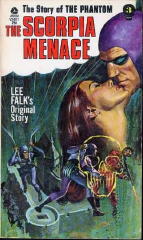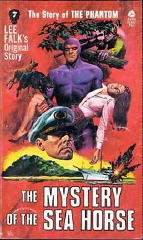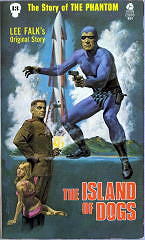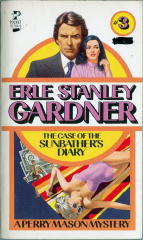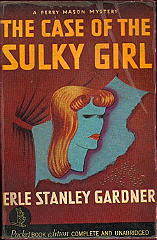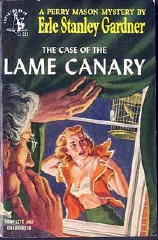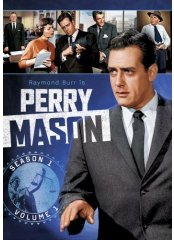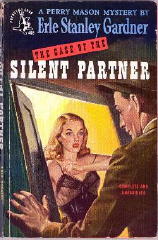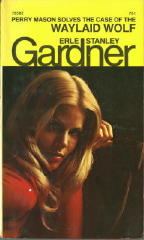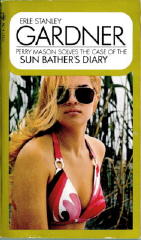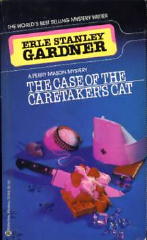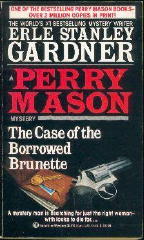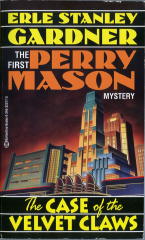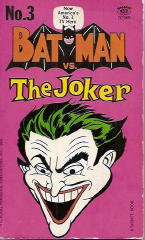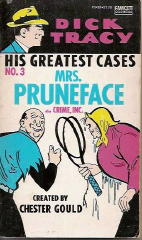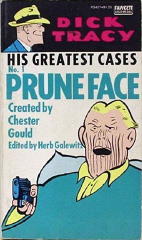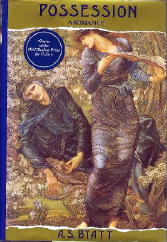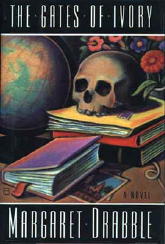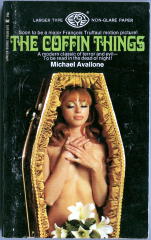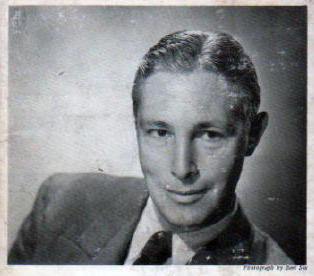September 2007
Monthly Archive
Fri 28 Sep 2007
I was “processing” a box of hero paperbacks the other day, and along with the Batman and Dick Tracy books (recently covered here) was a nearly complete set of the Avon adventures of comic strip hero, The Phantom. Nominally by Lee Falk, also the creator of Mandrake the Magician, identifying who the true authors really were is a complicated matter, and it has not been well-stated in Al Hubin’s Crime Fiction IV.
Using the books themselves as a guide, plus information found here and there on the Internet, here’s my attempt to untangle the true ownership of each of the books. Al’s been out of town this week, so my facts, as I’ve put them forth, are still subject to his approval. If you have any information to the contrary for any of the statements below, let me know. I’ve no qualms about correcting errors!
FALK, LEE (HARRISON). 1911-1999. Correction of year of birth. Born Leon Harrison Gross, he took his surname as a young man from the middle name of his stepfather, Albert Falk Epstein. American playwright and theatrical director/producer; best known as the creator of two comic strip heroes, The Phantom and Mandrake the Magician. The following is a complete rewriting of his entry in the (Revised) Crime Fiction IV. Several of the books in the series of Avon paperback originals were written by Falk. The rest were written by other authors; often these authors are named, but with the statement that the books were based on Falk’s original stories. SC in all titles: The Phantom.
_The Assassins. Written by Carson Bingham, a pseudonym of Bruce Cassiday, qq.v. Avon, pb, 1975.
The Curse of the Two-Headed Bull. Credited to Carson Bingham, q.v., on the title page, but in an Author’s Note, Falk states that the book was written by him. The attribution to Bingham was a publisher’s error. Avon, pb, 1975.
_The Goggle-Eyed Pirates. Ghost-written by Ron Goulart, q.v. Avon, pb, 1974. [The name Frank S. Shawn does not appear on the title page.]
_The Golden Circle. Written by Frank S. Shaw [sic], a pseudonym of Ron Goulart, qq.v. Avon, pb, 1973. Due to a publisher’s error, Goulart’s pen name for the series, Frank S. Shawn, was misspelled.
_The Hydra Monster. Written by Frank S. Shawn, a pseudonym of Ron Goulart, qq.v. Avon, pb, 1973.
_ The Island of Dogs. Written by Warren Shanahan, q.v. Avon, pb, 1975.
Killer’s Town. Avon, pb, 1973.
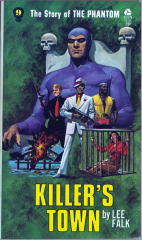
The Mysterious Ambassador. Avon, pb, 1973.
_The Mystery of the Sea Horse. Written by Frank S. Shawn, a pseudonym of Ron Goulart, qq.v. Avon, pb, 1973.
_The Scorpia Menace. (Corrected spelling.) Written by Basil Copper, q.v. Avon, pb, 1972.
_The Slave Market of Mucar. Written by Basil Copper, q.v. Avon, pb, 1972.
The Story of the Phantom. Avon, pb, 1972.
_The Swamp Rats. Written by Frank S. Shawn, a pseudonym of Ron Goulart, qq.v. Avon, pb, 1974.
The Vampires and the Witch. Avon, pb, 1974.
_The Veiled Lady. Written by Frank S. Shawn, a pseudonym of Ron Goulart, qq.v. Avon, pb, 1973.
CASSIDAY, BRUCE. 1920-2005. Add year of death. Pulp writer and editor, radio scriptwriter, and author of many works of crime fiction under his own name and several pseudonyms: Carson Bingham, q.v., Mary Anne Drew, C. K. Fong, Annie Laurie McAllister, Annie Laurie McMurdie & Michael Stratford.
BINGHAM, CARSON. Pseudonym of Bruce Cassiday, 1920-2005, q.v. To three crime novels written by the author under this pen name in the (Revised) Crime Fiction IV, add the following:
The Assassins. Avon, pb, 1975. Note: This is a book in “The Phantom” series, created by Lee Falk, q.v.
_The Curse of the Two-Headed Bull. Avon, pb, 1975. A book in “The Phantom” series. Credited to Carson Bingham on the title page, but in an Author’s Note, Lee Falk states that the book was written by him. The attribution to Bingham was a publisher’s error.
COPPER, BASIL. 1924- . Among other works of crime fiction included in the (Revised) Crime Fiction IV are six collections of Solar Pons stories, a character created by August Derleth, and 52 book-length adventures of private eye Mike Faraday. The two entries below are newly added here to the author’s own entry.
The Scorpia Menace. (Corrected spelling.) Avon, pb, 1972. Note: This is a book in “The Phantom” series, created by Lee Falk, q.v.
The Slave Market of Mucar. Avon, pb, 1972. Note: This is a book in “The Phantom” series, created by Lee Falk, q.v.
GOULART, RON(ALD JOSEPH). 1933- . Mystery & science fiction writer as well as a historian of pulps, comic books & comic strips. Add pseudonym: Frank S. Shawn, q.v. Other pseudonyms & house names: Josephine Kains, Chad Calhoun, Marshall Macao, Ian R. Jamieson, Kenneth Robeson & William Shatner. As Shawn, the author of several books in “The Phantom” series created by Lee Falk, q.v.
SHAWN, FRANK S. Add as a pseudonym of Ron(ald Joseph) Goulart, 1933- , q.v. Other pseudonyms & house names: Josephine Kains, Chad Calhoun, Marshall Macao, Ian R. Jamieson, Kenneth Robeson & William Shatner. As Shawn, the author of several books in “The Phantom” series created by Lee Falk, q.v. These are listed below.
The Goggle-Eyed Pirates. Avon, pb, 1974. [Note: The name Frank S. Shawn does not appear on the title page.]
The Golden Circle. Avon, pb, 1973. Due to a publisher’s error, the name of the author was misspelled as Frank S. Shaw.
The Hydra Monster. Avon, pb, 1973.
The Mystery of the Sea Horse. Avon, pb, 1973.
The Swamp Rats. Avon, pb, 1974.
The Veiled Lady. Avon, pb, 1973.
SHANAHAN, WARREN. Author of one book in “The Phantom” series created by Lee Falk, q.v. The title below, the only one in the author’s entry in the (Revised) Crime Fiction IV, is now directly attributed to him.
The Island of Dogs. Avon, pb, 1975.
OPEN QUESTION: It is unknown who Warren Shanahan was. He contributed to at least two combat-oriented collections of true stories published by Pyramid (One Against the Enemy, 1963; and Medal of Honor, 1967), but I’ve found no other writing credits for him.
[UPDATE] Later this same evening. On a hunch, I checked out Michael Cook’s Index to the Digest Mystery Magazines, and there was Warren J. Shanahan, author of five stories that appeared in Guilty (2), Trapped (2), and Manhunt (1), all in the 1950s.
Thu 27 Sep 2007
I was looking over the previous post here on the M*F blog this morning, the one on Gardner paperbacks, wondering if I need tweak anything here or there, and it occurred to me that that last cover was the only one that I could remember having a portrayal of Perry Mason on it.
Perhaps I could have you just go back and take a look, but since it’s handy, why don’t I simply show it to you again:
The covers on the earliest Pocket paperbacks, going back to the early 1940s, always seemed to me to be attempts to imitate the art on hardcover jackets, rather subdued and far from lurid:
Later on toward the end of 1940s, the covers at Pocket seemed more and more designed to do their job properly, to catch the eye of the guy (usually) at the newsstand:
That cover at the top of this page must have come from the end of the Pocket era. If that’s Perry Mason who’s pictured on it, it certainly doesn’t look like Raymond Burr, who was perfect in the part, but very much an establishment figure. He was a whole lot younger when he started, though. Here’s the cover of the recent box set, which I’ve bought but (all together now) I haven’t started to watch yet:
To me, the guy on the Pocket cover looks more like Monte Markham, who had the role for about half a season, 1973-74, before they pulled the plug on him. To TV viewers, it was Raymond Burr who was Perry Mason, and no one else. Even though he may not have been playing Mason at the time, this is what Markham looked like then:
But getting back to covers with Mason himself on them, I think I may have found an earlier one after all. It’s from the late 1940s era, and as a character, I don’t think all of his rough edges had rubbed off yet. Mason was a tougher guy at the beginning, his roots (as well as Gardner’s) being solidly in the pulp era, and more specifically Black Mask and Dime Detective.
I think those roots are still showing here:
Wed 26 Sep 2007
It’s almost 90 degrees in Connecticut today, and for September, while it’s not unheard of, it’s certainly unusual. It meant that I didn’t work in the garage today, though. What I did instead is bring in a box of paperback books that I bought while I was in Michigan visiting with my sister and brother last year.
Of course what this did was to bring back a few memories, of books purchased and being out of sight, the box never unpacked until now, long forgotten. There was a large assortment of westerns, but of the mysteries, most of them were Erle Stanley Gardner books that I’d purchased pretty much because of their covers, Perry Mason adventures all, and not because I didn’t already have them in other, earlier editions, because I do. That doesn’t stop me from collecting them. You do understand, don’t you?
By chance I also have a small lot of Gardner’s books up for auction on eBay. These aren’t the earliest in the Pocket editions – I think these are all from the 1950s – but the covers are nice. The two on the top are by Robert McGinnis. The one on the lower right is by Mitchell Hooks.
As the years went on, some of the Perry Mason books were reprinted umpteen times, and over the years the covers changed. In the late 60s, the books all had photos of beautiful women on the covers:
In the later 60s, the covers were trimmed in gold with another crew of beautiful models posing (perhaps) as one of the characters of their respective books.
I’m not 100% sure that I have the order correct in which these more recent Ballantine reprints came out, but I think I do. They began, I believe, in the early 1980s and were still going as recently as the year 2000. There seems to have been (at least) three different styles and formats for their covers. First this one:
then this one:
and finally this one, which of course I like the best – with quite a retro approach. The box from Michigan had about 15 of these in it:
Getting back to Pocket, though, one of the books from Michigan was this one, a style that I’ve never seen before. It’s numbered #3, but it’s not chronologically correct, since the book was first published in 1955 and hardly was the third Perry Mason adventure. There’s no date on it. All that it says is that it was the 11th printing. How many more there were in this series I have no idea.
Tue 25 Sep 2007
Forget the heading of this post for a minute. I have some personal comments to make first.
Over the past couple of weeks, I’ve been tied up with matters not involving the blog and blog-related activities, and so (as you may have noticed) I’ve not been posting here nearly as often as I did, for example, over the summer. Nor are things are very likely to improve, I’m sorry to say. As far ahead as I can see, I’m not going to have nearly as much free time as I’ve had up to now to sit here at the computer and provide with you anything better for reading material than this, what you’re reading right now.
Neither have I been able to keep up with comments that have been left, nor have I been replying in any kind of quick fashion to email questions that have been asked, and I apologize. I’m deeply sorry about that. If I’ve left you hanging in such a fashion, I probably haven’t forgotten about you, if that’s any satisfaction.
Time is, as one fine philosopher has said, what keeps everything from happening at once. On the other hand, there’s a mathematical principle that says that there’s only a finite amount of it. You can slice it as thin as you want, but the wafers will still add up to only 24 hours a day.
Besides helping John Pugmire recently with his Locked Rooms Library project, now finished, I’m still working on Al Hubin’s Addenda to Crime Fiction IV and as often as I can get to it. To me, it’s increasingly fascinating stuff. I also have another installment of “Maps in Mysteries” to post, and Victor Berch and I are working on a couple of illustrated checklists that should prove interesting.
Besides reviews from Mary Reed, which have nearly unforgivably been piling up, I have tons of my own to post, all old, as I’ve not written but one since March. I’d also like to get back to more “Compleat” profiles of authors, but unless something drastic changes, don’t look for another one for a couple of weeks more. Unless it’s a short one.
And you’ll see them here, eventually. But I guess that’s going to be the key word for a while. Eventually!
In the meantime, let me plug one of the best sources around for in-depth mystery-related news on the Internet, J. Kingston Pierce’s The Rap Sheet. Let me take that back. In my opinion, it’s the best, and I say that not only because Jeff’s recently given a big publicity boost to John Pugmire’s “Locked Rooms” article. Read the rest of the items on his blog, actually a collective effort, and you’ll see exactly what I mean. It is to enjoy, every post he makes.
While naming some but not others, I mean no slight to those not named, but Bill Crider’s Pop Culture blog is another that’s worth visiting every day, and I mean every day and usually several times a day. A post entitled “Memory Lane” proved to be a stroll down exactly that, a short history of mystery fandom through one fan’s eyes, Bill’s. While he and I have met in person only once, I think I was with him over the past 30 years, in parallel and sometimes coinciding paths, most of the way. Don’t miss it.
I’ve also just left some comments on Vince Keenan’s blog, this time perhaps stirring up a figurative hornet’s nest of controversy, unless everyone’s tired of arguing over the Question Without an Answer: “What is Noir?” Everybody knows, but nobody can convince anyone else.
Sun 23 Sep 2007
Over the past six weeks or so I’ve been working with John Pugmire, a long-time “locked room” aficionado, and the English translator of Paul Halter, the French writer who specializes in the genre, on an article about guess what? Locked room mysteries, of course.
To tell you the truth, John’s article has been done for most, if not all, of these same past six weeks. What’s been holding up the works has been me. The major part of the piece is a list of well over 100 locked room mysteries. What I’ve been doing in my spare time in the evening is adding cover images to something like 90% of them.
For more on what this is all about and where the list of books and authors came from, here’s John:
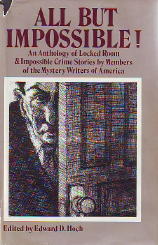
“Over twenty five years ago, Ed Hoch asked seventeen authors and critics to rank the best locked room mysteries of all time. The results were published as an introduction to the anthology
All But Impossible (Ticknor & Fields, 1981).
“Early in 2007, Roland Lacourbe, the eminent French expert on impossible crime fiction, decided to ask a group of fellow anthologists and translators to name 99 novels worthy of inclusion in the library of a hypothetical locked room aficionado. The results can be found in this article Steve has just told you about. Also in the piece I offer some thoughts on French Golden Age crime fiction and how it was influenced by the criminal justice system.
“Monsieur Lacourbe is French and so the original list of 99 was confined to books published in French. However, the article also lists a further 14 noteworthy novels not yet available in French, for a grand total of 113. A surprisingly high proportion – nearly 40% – of the 99 novels are French in origin and have never been translated into English: a great pity and possibly an opportunity for an enterprising publisher. Whether that happens or not, Monsieur Lacourbe will have performed the valuable service of listing, for the first time, the 70 or so best locked room mysteries in the English language.”
One small but perhaps not so incidental nugget of information that came from the research into the books is that Repos de Bacchus, by French author Pierre Boileau, was used as the basis for a book in English, The Sleeping Bacchus, as by Hilary St.George Saunders. (This was only book under Saunders’ own name. He may be more familiar to mystery fans as Francis Beeding, one of several pen names that he used.)
Not all of the entries have covers to go with them, but John and I are proud to have come up with as many as we did. Here’s the link to the page:
https://mysteryfile.com/Locked_Rooms/Library.html
If you’re a fan of classical mystery fiction, harking back to the Golden Age of Detection, I think you’ll like what you see. In fact, I guarantee it.
Sat 22 Sep 2007
BRIAN AUGUSTYN – Gotham by Gaslight: An Alternative History of the Batman.
DC Comics; graphic novel; 1st printing, 1989. Script: Brian Augustyn; pencils: Michael Mignola; inks: P. Craig Russell. Introduction by Robert Bloch.
What it is that makes (and establishes) a cultural icon is difficult if completely impossible to predict, but with plenty of hindsight at our command, it is absolutely certain that both the Batman and Jack the Ripper each and individually most definitely are.
Did they ever meet? Of course not, but on the other hand, why not? This particular graphic novel (or sophisticated comic book, if you prefer, with sturdy cardstock covers, glossy pages and no ads) was not designated with the “Elseworlds” label, but according the various comic sites on the Internet, it was the first, and it was so successful that an entire series of such novels followed.
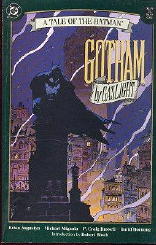
So what is (or are) Elseworlds? Allow me to quote from the equivalent of the DC handbook: “In Elseworlds, heroes are taken from their usual settings and put into strange times and places – some that have existed, and others that can’t, couldn’t or shouldn’t exist. The result is stories that make characters who are as familiar as yesterday seem as fresh as tomorrow.”
After Robert Bloch’s introduction, supplied just in case an unwary comic book reader does happen to be unfamiliar with Jack the Ripper – and a nice touch, at that – comes a retelling of the origin of the Batman: the holdup man who guns down Bruce Wayne’s parents before his very eyes; the young lad then devoting his life to take up the cause of justice against criminals and the underworld behind a mask, a costume and a long, free-flowing cape. Except this time it is the late 1880s, and this is not the current Batman at all.
At the same time as Bruce Wayne is taking up his new career, a horrible slayer of prostitutes in London seems to have made his way to Gotham, a city well-known to comic book readers as the home stomping grounds of the Batman, Inspector Gordon and all of the other characters of current legend (and so it appears) no matter what universe they may happen to be in.
The coincidence in timing is far too obvious for some, and Bruce Wayne, unable to account for his whereabouts and not being home at night, is first confronted, then arrested and convicted of being the Ripper. In his jail cell, going over the piles of documents, photos and other evidence against him, provided by Gordon, not convinced of his guilt, it is Bruce Wayne the detective that spots the clue that will nail the killer, if only he were not scheduled to be executed for the crimes himself in the morning.
Truthfully, however, while this certainly qualifies Gotham by Gaslight as an entry in Al Hubin’s Crime Fiction IV – it is not there now, but other Batman graphic novels are – the detection, if not minor, is hardly of the fair play variety. In terms of the reader playing detective him- or herself, this is also mere child’s play, as it were, there being only one other suspect and that being one who only appears in one previous panel.
The attraction here is the small delights provided by viewing the Batman legend from another perspective in an unexpected context – as if with new eyes – and the delightful art from Mignola and Russell. Grays and blues and browns dominate, as well as exquisite details in Victorian-era architecture, wearing apparel and facial foliage.
You have to be a Batman fan, perhaps – and if you’re not, it’s sure as shouting that I’m not going to make you one – but if you are, this is a sure-fire classic must-read.
[UPDATE] 09-22-07. I’ve reprinted this review, of course, because of the coverage of the original Batman in the previous post. Other than that, there’s been no attempt to rewrite it to make it more of a followup than this. It’s as I wrote it when it first appeared. But as I suggested, though, this particular book now does appear in the Addenda to the Revised CFIV.
Fri 21 Sep 2007
In his search for completeness in compiling his bibliography of the field, Crime Fiction IV, Al Hubin has cast a wider net than you might have imagined. In this particular blog entry, I offer two cases in point to illustrate this.
Most observers, for example might not consider Batman as a character whose exploits would be included in CFIV, but indeed they are, and quite extensively too, as long as they appeared in book form, including (more recently) graphic novels. Batman has gone several phases in his nearly 70-year-long career in fighting crime, and you could do no worse than to check out his Wikipedia entry for more information.
The current incarnation is an crime-obsessed, near-crazed madman with few friends, even among his fellow superheroes. More likeable was the Batman of the early 1950s, which is when he was one of my favorites, my old Golden Age. He never had superpowers, but besides being agile and athletic, neither of which I was, he also solved crimes by the use of his brains, an ability which I could much more easily identify with.
And of course his never-leave-home-without-it utility belt, one of which I always wished I had. For some reason, though, it never showed up in the yearly Sears Christmas catalog, no matter how hard I looked.
The entries for Batman in Part 19 of the Addenda are for a series of paperback originals from the 1960s, reprinting some of his adventures from my “Golden Age” of the 1950s.
KANE, BOB. 1916-1998. Noted comic book artist and writer. Add: Born Robert Kahn, he is said to have legally changed his name to Bob Kane at age 18. Note: In at least the three books indicated with a (*) below, Bob Kane is credited only as the creator of Batman as a character. Different writers and artists were in fact largely responsible for the original comic book stories.
* Batman. Signet, pb, 1966. Add: Collects the following Batman comic book stories, plus introduction:
The Legend of the Batman (Six page introduction:
Batman #1, 1940; reprinted from
Detective Comics #33, November 1939)
The Crazy Crime Clown! (
Batman #74, December 1952-January 1953)
The Crime Predictor (
Batman #77, June-July 1953)
Fan-Mail of Danger (
Batman #92, June 1955)
The Man Who Could Change Fingerprints! (
Batman #82, March 1954)
The Testing of Batman! (
Batman #83, April 1954)
The Web of Doom! (
Batman #90, March 1955)
* Batman vs. The Joker. Signet, pb, 1966. SC: Batman. Collects the following Batman comic book stories. Correction: There are only five, not six stories in this collection.
Batman – Clown of Crime! (
Batman #85, August 1954)
The Challenge of the Joker (
Batman #136, December 1960)
The Joker’s Journal (
Detective Comics #193, March 1953)
The Joker’s Millions (
Detective Comics #180, February 1952)
The Joker’s Winning Team (
Batman #86, September 1954)
* Batman vs. the Penguin. Signet, pb, 1966. Add: Collects the following Batman comic book stories:
The Golden Eggs (
Batman #99, April-May 1956)
The Parasols of Plunder (
Batman #70, April-May 1952)
The Penguin’s Fabulous Fowls! (
Batman #76, April-May 1953)
The Return of the Penguin (
Batman #155, May 1963)
The Sleeping Beauties of Gotham City (
Batman #84, June 1954)
This next character with a mention in Part 19 of the Addenda is more immediately recognizable as a detective, of course, that being Dick Tracy, star of comic strip, radio, TV, and more recently, the big screen. I grew up in a town where Tracy was the front page attraction on the Sunday comics section, but strangely enough, I never followed his adventures. I’m not sure why, but I think I always thought the artwork was a little too crude, the villains too outrageously unbelievable, or a combination of both.
No matter. Dick Tracy was, and probably still is, the epitome of a good guy, big city cop.
GOULD, CHESTER. 1900-1985. Cartoonist and creator of the long-running Dick Tracy newspaper comic strip. While his entry in the (Revised) Crime Fiction IV includes several other books based on the character, the three paperback originals listed below constitute three books in the “Dick Tracy: His Greatest Cases” series, one requiring a correction and one newly added.
Add: Mrs. Pruneface plus Crime, Inc. Gold Medal, pb, 1976. SC: Dick Tracy. Two stories in comic strip form.
Pruneface. Gold Medal, pb, 1975. SC: Dick Tracy. Comic strip reprints.
Snowflake and Shaky plus The Black Pearl. Gold Medal, pb, 1975. SC: Dick Tracy. Correction of title; two stories in comic strip form.
Tue 18 Sep 2007
As he does at regular intervals, Al Hubin sent me this morning Part 19 to his ongoing online Addenda to the Revised Edition of Crime Fiction IV, and within minutes (or so) I had it uploaded and ready to read.
There are no major discoveries in this installment, perhaps none that haven’t already been mentioned in these pages already, but for additions and corrections to the entries for authors ranging from Salar Abdah to A. T. Worden, you might want to take a look.
This new page is all in plain text, without the annotations I’ve been adding to previous chunks of the Addenda. I’ve recently finished Part 3, for example, on the main page, and I’m about to start merging it into the combined alphabetical sections of Parts 1 and 2.
Of possible interest are the following entries from Part 12, which indicate a family connection that hadn’t been pointed out before in CFIV:
BYATT, A(NTONIA) S(USAN) (née DRABBLE). 1936- . Daughter of J. F. Drabble, 1906-1982, and sister of Margaret Drabble, 1939- , qq.v. Broadcaster, reviewer, editor, prize-winning author. Of several novels, one is included in the (Revised) Crime Fiction IV as having marginal crime content. See below.
–Possession. Chatto & Windus, UK, hc, 1990; Random House, US, hc, 1990.
DRABBLE, J(OHN) F(REDERICK). 1906-1982. Add year of death. Barrister and county court judge; father of A. S. Byatt, 1936- , and Margaret Drabble, 1939- , qq.v. Author of one book included in the (Revised) Crime Fiction IV. See below.
Death’s Second Self. Sidgwick & Jackson, UK, hc, 1971. [Described by one online bookseller as “a diabolical crime piece.”]
DRABBLE, MARGARET. 1939- . Daughter of J. F. Drabble, 1906-1982, and sister of A. S. Byatt, 1936- , qq.v. Biographer, critic, and prize-winnning author of many works of fiction, including one novel cited in the (Revised) Crime Fiction IV. See below.
The Gates of Ivory. Viking, UK, hc, 1991; Viking, US, hc, 1992. [A London psychiatrist receives a cryptic package in the mail. Deciphering the message leads her to the chaos and corruption of Southeast Asia.]
From the sublime, in terms of status in the literary world, to the less so — and I say this even though the late Mike Avallone was a friend of mine — we have the following entry from Part 18. [Note that this does not constitute the entire body of work for the previously mentioned Mr. Avallone. All that are listed here are the titles requiring additions or changes.]
AVALLONE, MICHAEL (ANGELO, JR.)
The Coffin Things. Lancer, pb, 1968. Add setting: NY State (the Adirondacks). Note: According to the front cover, the book was “soon to be a major François Truffaut motion picture.” The movie does not appear to ever have been made.
The Werewolf Walks Tonight. Warner, pb, 1974. #2 in the “Satan Sleuth” series, which relate the occult adventures of Philip St. George, a masked avenger who fights the forces of darkness. Add setting: Tennessee-Kentucky border.
Note: There were three books that appeared in the Satan Sleuth series. According to one website no longer accessible, Avallone wrote two others that have never been published:
* VAMPIRES WILD (unpublished 1975) Philip St. George combats sorcery and Satanism in cynical Hollywood and comes face to face with the oldest living movie star. Is timeless Lola Vane actually who and what she seems to be? Do vampires really walk again in the modern age?
* ZOMBIE DEPOT (unpublished 1976) Philip St. George travels to Haiti to fight the legendary Baron Samedi, the Man Who Will Not Die. Not even Voodoo can explain the existence of The Python, incredible ringleader of a cult beyond sanity.
Mon 17 Sep 2007
It was well over a year ago that Victor Berch, Bill Pronzini and I put together our annotated bibliography of Dutton’s line of Guilt Edged hardcover mysteries, and luckily we haven’t had to make very many corrections.
The Guilt Edged line lasted from 1947 to 1956, with the two most highly collectible authors in the group arguably being Mickey Spillane and Fredric Brown. There were lots of unknowns as well, but William Campbell Gault was a Guilt Edged author, and so were Lionel White, Stewart Sterling and Sam S. Taylor.
If you know all of those names, congratulate yourself. If you know all but the last one, give yourself only half a pat on the back. It was in Sam S. Taylor’s entry in which we recently discovered that we were in error. According to all of the sources we consulted at the time, Taylor was supposed have died in 1958, soon after his last book. Not so, and I’ll get to the correct date in a minute.
First, though, is Taylor’s complete entry in Crime Fiction IV, by Allen J. Hubin, as it stood until a few weeks ago, slightly edited and expanded.
TAYLOR, SAM(UEL) S. (1895-1958); see pseudonym Lehi Zane; Radio and film scriptwriter, short story writer. Series Character: Neal Cotten, in all titles.
* Sleep No More. Dutton, hc, 1949. Signet 821, pb, 1950. Boardman, UK, 1951.
* No Head for Her Pillow. Dutton, hc, 1952. Signet 1057, pb, 1953. Foulsham, UK, 1954.
* So Cold, My Bed. Dutton, hc,1953. Signet 1247, pb, 1955. Foulsham, UK, 1955.
ZANE, LEHI; pseudonym of Sam(uel) S. Taylor
* Brenda. Gold Medal 264, pbo, 1952. Red Seal, UK, 1957.
It turns out that both dates for Mr. Taylor were wrong. After reading our first efforts, one of his sons emailed me, stating that his father died in 1994, not 1958. This was enough to go on. Victor then did a search in Social Security records and came up with a Samuel S. Taylor who was born October 11, 1903 and died February 1994 in California.
Having a ready-made excuse for compiling a compleat profile, we did, and here is the result. Jackets of the hardcovers in the Bill Pronzini collection provided the blurbs and other information. The paperback covers came from various other sources. I still can’t get to my own accumulation of books.
First a photograph of Mr. Taylor, found on the back cover of his second book, along with a short biography underneath it:
ABOUT THE AUTHOR:
Sam S. Taylor, author of No Head for Her Pillow, is the author of one other mystery story, Sleep No More, published by E. P. Dutton & Company in 1949. Innumerable radio scripts, and a good many magazine stories round out a full writing career.
Upon receiving a medical discharge from the U. S. Coast Guard in 1943, Mr. Taylor affiliated himself with the Army Signal Corps as expert consultant on training films, where he also wrote many scripts for Army posts.
His personal interest in crime (from the observer’s seat) stems from that time when, as a member of the New York City special panel of jurors, he was called to serve on the famous Jimmy Hines case, prosecuted by Gov. Thomas E. Dewey.
When Mr. Taylor first married his beautiful French Canadian bride, she spoke no English; Mr. Taylor now has a French accent after three years of marriage.
Mr. Taylor makes his home in Tarzana, California, with his wife and baby.
SLEEP NO MORE.
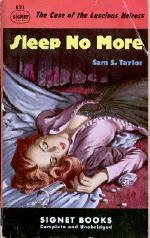
From the hardcover front dust jacket flap:
Delving into the private life of a luscious copper heiress, especially one with a tangle of soft red hair and a roving eye, was going to be a pleasure
Or so thought Neal Cotten, head of the brand-new Cotten Bureau of Investigation. That was before a simple case of blackmail developed into a hunt for a desperate killer … a grim hunt that led from a luxurious mansion in Pacific Crest to a shoddy flop-house on Skid Row; from a remote ranch in Nevada to a crooked gambling house in Angel Gardens.
The chase uncovered a secret rendezvous high up in Clearwater Canyon, a will with some startling changes, a fat bankbook hidden under a filmy negligee, a muscle-bound extra who didn’t go to Reno — and a handsome movie idol who played with fire once too often
But none of it made sense. Not until Neal took Jennie, the Polish waitress, to see Madame Butterfly … and Jennie innocently gave him the lead that cracked the case wide open.
A swift-paced tale of homicide and passion, of violence and corruption, set against the vivid background of Los Angeles, Sleep No More will be devoured by mystery fans in one breathless sitting.
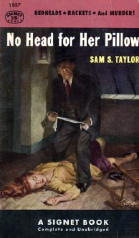
NO HEAD FOR HER PILLOW.
From the hardcover front jacket flap:
It may be an everyday occurrence among artists and art dealers to mutter vindictively, “Oh, I could kill him!” as it is among the brotherhood of almost any other business.
No Head for Her Pillow has a couple of artists, an art dealer, some racketeers, some newspaper people, and Neal Cotten, director of the Cotten Bureau of Investigation and his own chief operative. It was a good thing for California art circles that Neal was hired by Colonel Millard Baldwin, publisher of the San Vincente Sun, to aid in the Sun‘s campaign against the slot-machine racket in the city.
It happens that Col. Baldwin’s two daughters, Sharon and Diana, were on intimate terms with the others of the San Vicente art world, one being a painter, the other a sculptress. Diana, the sculptress, appeals mightily to Neal Cotten who sees her as a “king-size dame with a mass of sunset hair.”
Investigations, of whatever kind, often lead to murder, as well as vice versa, and slot machines sometimes turn up more than merely lemons. The proof of these adages is offered, with dividends, in No Head for Her Pillow, a fast exciting mystery that is almost as tough as a forty-cent steak.
SO COLD, MY BED.
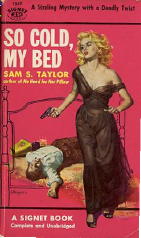
From the hardcover front jacket flap:
Private eye Neal Cotten has a visit from a beautiful doll who commissions him to trace her aunt, an oldtime actress. Her story sounds phony but she pays cash so he takes the job. His first link to her whereabouts is a thug who offers to sell him information, but the deal is never closed. The thug is murdered.
Neal stays with it and finds the old actress who spends most of her time in a specially made coffin. Then Neal gets a new client — the governor’s wife, no less, who thinks her stepdaughter is running in bad company. There is a link between the murdered thug and his pals, the beautiful client, the lady in the coffin and the governor’s family, but it is one murder and many near misses later that Neal gets the pitch and solves the case, with a night club singer in distress slowing up the process considerably.
Sam Taylor is already known for his original and fast-paced mysteries through his earlier books Sleep No More and No Head For Her Pillow. His new one, So Cold, My Bed spells top entertainment for the mystery fan as it again features Neal Cotten, the hard-boiled but likeable private eye who has a way with the ladies and an affinity for easy money and screwy cases.
BRENDA.
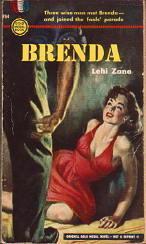
From the front cover:
Three wise men met Brenda — and joined the fools’ parade
From the back cover:
BRENDA
There was the simple, pious valley town.
And there was luscious, lustful Brenda.
The hard-handed farmers knew work — and prayer.
Brenda knew pleasure — and conquest.
Tragedy rode on the wings of passion when good and evil clashed.
Sam S. Taylor also published five criminous short stories in the early 50s:
“Summer is a Bad Time” — Manhunt, October 1953.
“A Clear Picture” — Manhunt, May 1954.
“State Line” — Manhunt, September 1954.
“The General Slept Here” — Manhunt, April 1955 (with Neal Cotten).
“Dig It, Brother” — The Saint, May 1956.
Fri 14 Sep 2007
Hi Steve
I’ve come to Mystery*File via Steve Holland’s Bear Alley and his mention of your recent entries about the British writer T. Arthur Plummer.
You have a fascinating blog, with tons of material that interests me. For instance, I began reading Sexton Blake books when I was eight or nine, and I began my working life at Fleetway House as editor W. Howard (“Bill”) Baker’s junior assistant on the venerable detective series when Michael Moorcock left the company in 1961.
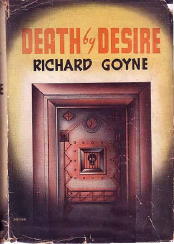
Like yourself, I haunted my local public library’s grown-up section from a very young age, borrowing Saint books and the like on my dad’s library card. So, since this was in England, I was well aware of Plummer’s Frampton titles.
These days I live in New Zealand and write for a UK genre fiction line published by Robert Hale Ltd — Black Horse Westerns. I also run a website at www.blackhorsewesterns.com . You might enjoy the article “Detectives in Cowboy Boots” in the March-May edition. [I’ve read it, and I recommend it highly to everyone reading this. –Steve]
You’ve mentioned having a primary collecting interest in writers like Plummer and Andrew Spiller. Another I remember was Richard Goyne. They were regular fixtures on the Stanley Paul/John Long catalogues in the 1950s and later. Others were W. Murdoch Duncan and the now famous Ruth Rendell. A few years ago, I picked up a positively shocking sum of money for a first-edition copy of Rendell’s first book, From Doon With Death (1964) in “fine” condition. When I say the money was more than I can earn in three months of writing, I’m sure you’ll understand why I couldn’t say no to the offer.
All the Paul crime authors were absorbed eventually into the Long list as part of a Hutchinson group rationalization. Yes, they did make such moves in the publishing industry even back then, though they might not have called it “rationalization”.
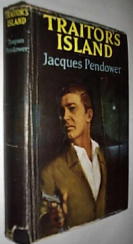
Another writer from the Stanley Paul stable was T.C.H. Jacobs/Jacques Pendower, with whom I later had some dealings when editing westerns and the Edgar Wallace Mystery Magazine in the 1960s. You can pick up on some of this in the “Detectives in Cowboy Boots” article.
To continue with the blog comments made in connection with Plummer, I don’t think any of these writers of the past wrote to achieve immortality. I doubt whether the thought entered their heads. Money was one driver. Another was that writing fiction is for many something like a drug — you just can’t kick the habit.
No way will I or my writing fellows of today achieve immortality, by the way. The print-runs for hardcover library fiction are even shorter than they were in Plummer’s time. After all, each copy is going to have a hundred or so readers in its lifetime. So don’t expect to find them on Abe or equivalent sites in 50 years’ time! My latest western, Misfit Lil Fights Back, was published on July 31. By August 17, the publisher’s warehouse was out of stock and the title was deleted from his online catalogue after just over two weeks of “life”. Reprints — other than in large-print editions, again for libraries — are unheard of. In some ways, this can be very dispiriting.
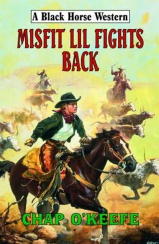
I’ve heard from others besides yourself, Steve, that westerns in your country are nearly an extinct breed. “Except for the steady line of sexy westerns, which I don’t read,” you say. To look on the brighter side, Hollywood is going through one of its sporadic revivals of interest and there’s a lively new blog, the Saddlebums Western Review. [A site that’s gotten off to a great start. I hope they can keep it up. –Steve]
I was interested in what you had to say about the “sexy” western lines, not because I sprinkle my work with gratuitous scenes — as some of the anonymous authors for those lines have done in the past — but because I do like to write a genuine adult story. This does sometimes cause problems. Conservative library-book publishers have their worries about “violence towards the women characters,” for instance.
I take care to see that the sex/violence in my books is woven into the fabric of characterization and storyline. Also, observations on the morality, the beliefs and social behaviour of the times are based on careful research. Generally, I believe unfudged scenes are what an adult reader of fiction in 2007 expects to find. The old “show don’t tell” imperative is stronger than ever and very evident in successful books, movies and TV programmes.
I understand that US publishers Five Star have lately put out the original, unexpurgated version of Zane Grey’s Riders of the Purple Sage. One day I hope to obtain a copy and study the differences.

I also found your blog entry on western writer L. P. Holmes. Your comments on the crime component in westerns are well put, and coincide with my — and many others’ — conclusions. [This was in a review of Edge of the Desert, which he wrote as by Matt Stuart. Alas, my coverage of western/crime fiction has dwindled greatly since then. –Steve]
By all means use my email as a blog post if you think that fitting, though you’d be right in saying it’s off-the-cuff stuff. Short on startlingly new facts, for sure. I enjoy the reminiscing, but pleasant though it can be, it does cut into your more productive writing time. As I recently told another blogger, I try not to look back for “greatest satisfactions” in life. I’m sure that for me the notion the best lies somewhere in the past carries with it the danger of making me a melancholic. I look for satisfactions in the present and I’m content when I finish my latest book convinced that from one aspect or another it’s the best thing I’ve written.
— Keith (Chapman aka Chap O’Keefe)
Next Page »

